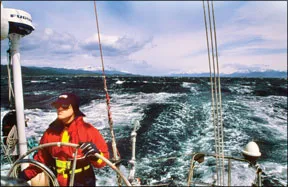It always seems that a storm rolls into Annapolis, Md., just in time for the United States Sailboat Show. Held in October, the annual exhibition is the nations biggest sailboat-only show.
Until this year, my favorite show was in 2006, when a 40-knot gale whipped into town, and the floating docks rolled like a Nantucket whaler with her decks awash.
With the wind and spray lashing the show tents, boat buyers defiantly carried on, one hand groping for a lifeline, the other grasping the credit card.
This year’s storm was of a different sort. There’s something eerily soothing about a large crowd of people ogling new boats while the world markets go into a death spiral. During the shows opening day, five televisions in the waterfront bar Pusser’s Landing tracked the Dows precipitous plunge. In one fell swoop, my boys college fund and any hope of retiring before I’m deaf as a post were carried off in an avalanche of debt. To my surprise, the people around me seemed preoccupied with only boats.
By all appearance, sailors were dealing with the economic storm of 2008 the same way they survived the slippery docks in 2006. They were buttoned down, but happy-sipping dark-and-stormies, thumbing through cruising guides, checking sightlines from the helm of 50-foot sloops. They were talking about chartplotters, EPIRBs, anchors, and turnbuckles, anything but the world outside. They were, like you and me, a little bit mad.
These days, there is something to be said for dementia.
Which leads me to Evans Starzinger and Beth Leonard, whose tireless work in the remote fjords of southern Chile yielded our reports on heavyweight anchors for challenging situations and cold-weather gloves in this month’s issue. While most sailors dream of tropical islands and warm breezes, these two-time circumnavigators thrive in some of the most challenging cruising areas of the planet.
“I don’t like the heat,” Beth explained two summers ago when the pair had paused in San Francisco. Being a sub-tropical sailor, I have a different take on ideal climate, but I couldn’t argue with her reasoning.
Certainly there are land-lubber types who think that beneath this passion for charging past the 50th parallel lies an element of madness. But I’m sure that even the chronically seasick find inspiration in what Evans and Beth are doing—especially today. As the Great Recession turns our quest for fortune ashore into an empty folly, the dream to “just sail away” doesn’t seem so crazy after all.
Whatever storms may lie ahead, I am buoyed by this thought. Cruising sailors are an independent lot. Give us a boat, some water, and food, and we’ll be fine for weeks at a time. Let the rest of the world think we’re wing nuts. The mess we’re in belies the truth: The loony bin, as any sailor knows, begins just north of the high-water mark.
Darrell Nicholson
Editor



































